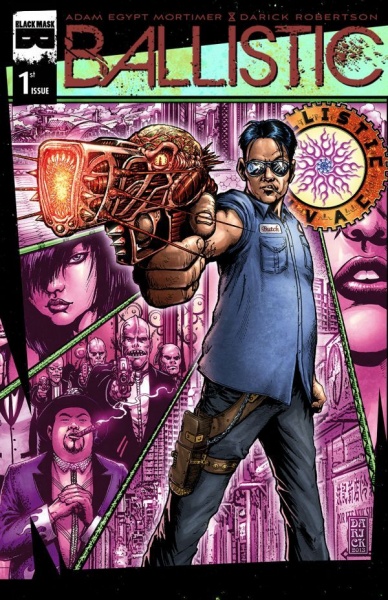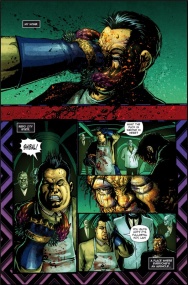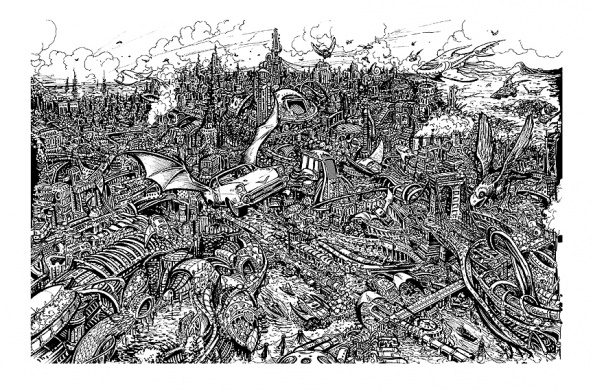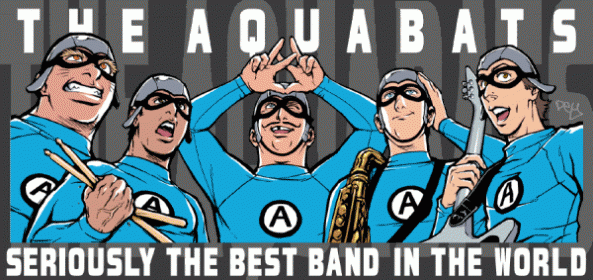
You wake up. You roll out of bed, ready for another day of air-conditioning repair. When you go to make some toast, though, the toaster calls you an asshole and, in the background, you can hear your best friend — who is also a gun — laughing at you. Welcome to Repo City State!
“Ballistic” is the collaboration of Adam Egypt Mortimer, director of the upcoming Sinatoro film (you know the one) and Darick Robertson, artist of “The Boys,” Transmetropolitan,” “Happy” and probably a half dozen of your other favorite comics from the last few years. Together they’ve combined forces, thanks in part to the Aquabats, to tell the story of Butch and his adventures in Repo City State, one of the most surreal sci-fi landscapes you’ll ever encounter.
Here’s the solicit to whet your appetite:
Welcome to Repo City State, where everyone’s an asshole – even the air conditioners.
Darick Robertson (Happy, The Boys, Transmetropolitan) and Adam Egypt Mortimer’s (director of Grant Morrison’s upcoming Sinatoro) madcap, psychedelic, transreal, utterly-wacko buddy adventure about Butch and his best friend Gun, a drug-addicted, genetically-modified, foul-mouthed firearm, as they attempt to elevate Butch from air conditioner repairman to master criminal in the twisted, post-eco-apocalyptic Repo City State, a reclaimed trash island built entirely from DNA-based, living technology with bad attitudes.
Ballistic marks Darick Robertson?s return to the hard sci-fi worldbuilding of his classic Transmetropolitan but mixed with The Boys’ ultra-violence and the lunacy of Happy. Mortimer’s mix of speculative science, pulpy noire, and drug-addled adventure cooks up a strange brew of Lethal Weapon by way of Cronenberg meets Dr. Who if written by Odd Future.
Read on as we chat with Adam and Darick about all things “Ballistc”
I understand that this is a book that has been in the works for some time. Can you talk about how you two came together to work on the comic?
Adam Egypt Mortimer: Darick and I met at San Diego comic con many years ago and got drunk. We then became drinking buddies when we were both living in New York. At some point around then I had the idea to do a story about a guy with a sentient gun, and I wrote the outline for a short story version of it. Then Darick and I were at SDCC again, on our way to see the Aquabats play, and I pitched him the idea of a guy with a talking gun riding in a flying batwinged car. The idea stuck for Darick and we started talking about it.
Since the original idea was birthed, what changes has the book undergone to get to where it is now?
AEM: More than anything, the world in which it’s set has changed, grown, evolved. Sometimes you start a story with a specific image – a scruffy white dude having an argument with his gun – and then you have to find the world in which that image makes sense. Earlier on we had your sort of generic sci-fi future city. And we asked, “Who is this guy and why is his gun screaming at him?” The idea of Repo City State – an island, built from molecularized garbage, somewhere in Asia, using technology that is entirely genetically engineered and alive – that idea took hold as an answer to the question.
The book itself seems relatively surreal, which seems appropriate given the blender mix of things cited to describe the book (Lethal Weapon by way of Cronenberg meets Dr. Who if written by Odd Future). To what extent do you see the book as kind of an idea-laden jam session between the two of you?
AEM: Yeah, that’s exactly right! It’s totally an idea-jam, where we’re each bringing our instrument and our skills to the table, and we’re playing within a certain set of rules about how the world works and who the people are. We had a lot of back-and-forth to understand certain things about Repo City State and what the technology can do and what it might look like. But the idea is king in this book. There’s a certain density that we’re shooting for, and hopefully achieving, and that density is a thick syrup of ideas. The ideas come from a TON of constantly updating research into cutting edge science, fringe theories, observations, and futurist guesswork.
Continued belowI think you’re right that it will be characterized as surreal. But not in the sense that we are not bound by the logic of a hard science fiction action world. I think it feels surreal because the future WOULD FEEL SURREAL if you suddenly stepped into it. That’s the key to the feeling of the book – from the way information about the world is parcelled out, to the hallucinatory moments to the shimmering dissonant background designs Darick puts into each page – the readers will feel as if they’ve woken up in the future and it is coming AFTER THEM.
We’re not trying to predict the future, but we are trying to give you an experience in the present, that combines an extreme version of the present with a possible trajectory of human culture.
Darick Robertson: What’s been so different is that Adam and I communicate often and aggressively back and forth about concepts, ideas, notions… Adam and I will send each other interesting articles about science and find justifications for the world we’re imagining in real life science. I recall watching a documentary about under water “Black Smokers” which are Hydrothermal Vents deep underwater and remarkably responsible for a variety of minerals and life forms at a depth scientists once believed life could not exist. Some now speculate that’s how life began to form on Earth. At the same time I was reading about this trash Island twice the size of Texas floating in the Pacific and thought if one could harness that trash Island and have one of these Black Smokers churning up life below it, it would turn into something living again and solve the problem. I presented the idea to Adam and we’ve been running with that ever since, as his world vision fits that theory perfectly.

In terms of the collaboration, what is the process like for you in working together on the book?
AEM: We’re very collaborative. Finishing the first issue was a several-month long process that had a lot of back and forth. Working through the look and feel of Repo City State was an intense process. Darick needed to find his way into how he’d see it and how he’d draw it, and I needed to find my way in how best to communicate to him. I wrote a draft of the script, and then we’d talk on the phone about it, and he’d have tons of ideas and questions and suggestions, and then I’d revise the script, and then he’d start pencilling. Darick had an idea that a certain character (sorry, can’t say who!) should show up earlier in the story, and then when I went to make that change I discovered amazing new possibilities. Darick came up with the idea for Butch’s tattoos, which are just a wonderful point of connection – literally – between him and Gun.
Sometimes I’ll see a little details in the artwork, and then expand on it later in the story. This is how Arborman was born – the mythological mascot of Repo City State, not unlike the Mer-Lion of Singapore.
I’ve loved comics my entire life, and I’ve tried my hand at writing some limited short story comics in the past, but my professional life has been dominated by filmmaking. With Darick’s help, I had to change some storytelling techniques to make what I think drawable. But my personal intention with this book has been to do something that could only be done in comics, to make a unique story that’s utterly unique to the format. And Darick has such a strong sense of how to best break a story into panels.
Sometimes I’ll get a call from Darick, and I can hear a kind of trepidation or even suppressed panic, and he’ll say something like, “on page 17, I had to make an executive decision and change the flow…” and then I’ll look at the pencil breakdown of a page and it’s always awesome. It’s always an upgrade to the script. And then we I see inks — man, I can’t tell you how psyched I was to see, for instance, the BANK ROBBERY sequence in issue 1. The rendering of the bank as the “spine of the city” and the sequence in which we see “TRANSACTORS IN VATS OF LIQUID CAPITAL”… it’s just mind blowing to see that stuff become physical.
Continued belowUltimately, the secret to the collaboration is, I’m primarily here to inspire Darick into doing amazing work, and he’s here to make this world come to life! Honestly, he’s making me look good.
DR: I get concerned when what I’m seeing in my imagination isn’t what I am capable of putting into the format of comics. Adam’s sense of film-making dominates the way he approaches this process, and it clarifies for me, the stark diverging points between what works on film and what works in a comic book. I try to treat my collaborator’s scripts with a great deal of respect, getting the nuance and details they’re after while executing the story as closely to the writers vision. Whatever panic Adam senses comes from me trying to protect those ideas while making them work in the comic.
AEM: I think on a project like this, the pure ferocity of imagination is going to make Darick and I both look as though we’re quivering in panic, foaming at the mouth trying to make it all work. I personally derive a lot of inspiration from panic, anxiety, and all those other adrenaline-fueled emotions. So I mean panic in only the most productive sense. If we’re being true to ourselves, the book will make you fucking panic when you read it.
DR: I am just trying to figure out how I’ll draw all of this in time for it to ship on schedule!
AEM: People want to talk to us about the differences or similarities are between film and comic. In one way it’s like asking what’s the difference between ceramics and haiku. But really, we’re just telling stories. What I’m bringing from film more than anything else is the collaborative process. I’m working on a movie right now, rehearsing a script, developing the visual language. When you work with actors, you are in some sense completely at their mercy — and that’s a good thing. If they come to set that day and they hate their father, or they’re having an affair, or they just rescued a kitten — this is going to wind up emotionally in the scene. And that’s great, you embrace the chaos of life and the roiling stew of reality that is created in collaboration. And it’s not just the actors — your production designer has maybe been haunted by something in her life, and it’s going to show up when you start working together on the design of the spaces in your world. Collaboration is what makes films great, and a great experience.
So I think I’m bringing that experience from film to Ballistic. Darick and I are working with enough back and forth communication and development that the pages evolve and mutate from one static idea into a growing living thing. We’re really having an idea baby together.
Just reading about the book’s narrator Butch – a failed bank robber with a talking gun – sounds like a pretty wild concept. How does a character like Butch survive in this incredible techno-centric world of “Ballistic?”
AEM: He’s a well adapted part of the herd. He fixes air conditioners, which in this insanely hot Asian city, is a in-demand profession. He’s actually quite gifted with a lot of technology – both his car and Gun are pieces of technology that Butch hot-rodded and customized. He’s got these nano-machinery tattoos built into his skin that interface physically with Gun. He’s got a great intuitive understanding of how physical things work. He knows how to fix things, build things, rig things. We see early on in the first issue he gets out of an intense lethal situation with some well-played jury-rigging.
His problem isn’t that he can’t survive day to day, it’s that he dreams too big. He wants to be a legendary heist-man, and he’s surrounded by the most dangerous assholes on the planet. He wants to be John Dillinger, but he’s kind of stuck, mentally, doing his job. I actually think almost anyone can relate to Butch — anyone who has ever dreamed big but hasn’t yet taken the right steps to make the dreams come true. Or anyone who has taken those steps — and then found as a result that the entire world is coming down on you because of it. Butch makes terrible, god-awful mistakes. That’s what makes it fun to see him in action.
Continued belowDR: That’s actually an aspect of the character I love most. He hasn’t thought everything through, yet is surprisingly capable when he thinks on his feet. More lucky than smart, I suppose, but it makes for some funny moments and I like a lead that doesn’t do everything just right. Reminds me of what I love about Han Solo.
AEM: Yeah, Han Solo is a great point of reference. And we’re looking at that relationship with technology that isn’t quite doing what’s it’s supposed to, just like Han and the Falcon.
DR: “Don’t worry, she’ll hold together. You hear me, baby? Hold together!”
AEM: Except by the end of issue 2, just about nothing is going to hold together… Luckily there’s never going to be a debate about whether or not Butch shoots first, since Gun is running that conversation
What goes into the physical design of a character like Butch? Visually he doesn’t seem like a guy who’s your typical hero by any means.
DR: While at times I think I see Adam’s initial idea like a Jet Li character in an awesome Sci-Fi world, what comes through is Butch’s everyman quality. I went for a grease-monkey, mechanic feel and that brought Butch to life for me. I wanted to create a guy that looks like he’s capable of doing what he does, but also who doesn’t have six pack abs, that maybe drinks too much of whatever Repo City State serves as beer (If Adam’s thought it up, it will be Spider’s milk, of Jellyfish venom)…

While I may be reading the description of the book a bit wrong here, to what extent would you call the book a “buddy comedy,” albeit a seemingly untraditional one?
AEM: That is EXACTLY what it is! It’s 100% a buddy comedy, it’s Lethal Weapon where Mel Gibson is a talking gun. That kind of buddy action comedy – Lethal Weapon, Last Boyscout, 48 Hours, Midnight Run – that is the key piece of DNA in the American Action story, and so it is evolved here in BALLISTIC. This is meant to be, after all, the NEXT STAGE OF EVOLUTION in the American Action story, evolved to survive in the brutal biosphere of our bold new reality.
DR: That’s the aspect that really got to me. I love, and hopefully meet, the challenge of making this bizarre GUN emote and be funny, and sympathetic. Having grown up loving Star Wars and seeing how my kids react to R2-D2’s emotional beeps and hoots the same way that I did thirty years ago, says to me that you can make people fall in love with a trash can with lights and wheels, if you play it correctly.
The world of Repo City State is such a sprawling landscape of science fiction. What sort of sci-fi influences are you pulling from in the creation of this place?
AEM: Actual science is a huge inspiration. The ur-story that really got me going was the genetic fusion of spiders and goats in the DNA-based material sciences. I read about that a long time ago and you can really see how that’s been a key to the world. A day doesn’t go by where I’m not reading about experiments and designs that somehow relate to this story. Io9 has been extremely helpful here; New Scientist. I’m constantly reading about genetic engineering, visionary architecture, bio-friendly design.
As far as science fiction sources: David Cronenberg is an influence on me. You don’t see his tone in this book, but you do see some of his vision, his conceptual framework. Videodrome and Existanz, primarily.
William Gibson is another big one; I think what I’m taking from him as a writer is to look for the details of the world; to see the science-fiction city as a setting where humans express their nature through infrastructure, subculture, and technology.
Philip K Dick’s humble everyman heroes and drug-addled futures are important to me. Jonathan Lethem’s Gun With Occasional Music, Lauren Buekes’ Zoo City, the novels of Jeff Noon and Stephen Aylett. The tense visual richness of Steranko’s Nick Fury comics from the 60s. William Burroughs’ world of Interzone.
Continued belowWe’re combining science fiction with the genre of crime fiction. In that way, you’d have to cite Blade Runner. But I don’t think our vision of the future looks anything like Ridley Scott’s.
The Fifth Element has the best flying car and madcap urban sci-fi of anyone, so that influence is undeniable.
Looking just at some of the preview art alone, specifically the splash with the flying car, this whole thing looks rather remarkably fleshed out. Darick, can you talk a bit about what goes into the creation of this page, both in the minute details and in the grand spectrum?
DR: I’ve dedicated this first issue to Jean Giraud (Moebius) who did graced us with the three covers for Transmetropolitan he created back when, and absolutely blew my mind with his work in Heavy Metal. This is in some ways, my hero worship having a place to flow. Moebius was such an innovator and creator of fully realized worlds, executed with such simple line work and use of composition, that I feel this work is me following everything I’ve derived from seeing and reading his work over the years. Also, Geiger, for his incredible ability to make the mechanical look organic.
My ongoing challenge is to not repeat myself, and follow that line between a world that looks tangible but is also fantastic. A world where you think you are where we’re taking you. Our colorist, Diego Rodriguez, has been essential in bringing the texture and tone of this world to another level of that tangibility. His color work in this has been inspired. That splash page took me four days to complete, and I broke it down into a grid, so everyday it was like filling in tiny panels until I had the complete image. Then Diego, taking notes and following direction generously, came back with the final and just made the piece come to life. It was truly one of the most demanding and rewarding things I’ve drawn to date.

In terms of how you approach the book, what is difference here for you between this and Transmet?
DR: This world was primarily grown, not built. Transmetropolitan was a world where Utopia got drunk, and media and politics began to feed on itself. Spider Jerusalem was the last stand in a world where bullshit ruled and technology placated the masses. Ballistic is a different beast, so I am going for shapes and curves rather than steel structures and hard angles. This is a world born of a trash island. The world of Spider Jerusalem would have fallen to ruin when this one was created. There are commonalities, as I am once again playing with a future city, but I see these places as very distinct from one another and hope that comes through.
I like the idea of every piece of technology being sentient within the story, although I do detect a slight hint of playful techno-paranoia in the idea. To what extent do you think something like this could even happen? Is “Ballistic” really the future?
AEM: I don’t think it’s techno-paranoia. It’s bio-paranoia. It’s bio-noir. Repo City State is in some ways a technological utopia. We’ve solved the eco-pocalyspe! We’ve got flying cars! We’ve synthesized the greatest possible drugs and we can make our bodies be whatever we want! But it’s still a world ruled by humans – and humans are insane.
Look at the present – we’re all currently walking around in constant snuggle communication with these sleek mini-monoliths of technology permanently fused to our hands, pieces of technology which from an outside perspective really do seem to be directing our actions and attention. I mean, the phones are in control, folks.. We’re already beyond any insanity that PKD predicted. The world of BALLISTIC feels pretty nuts, by design, but I don’t think we’ve invented anything that couldn’t actually occur within a century.

In terms of the book’s place in the market, what itch are you hoping this book will scratch for the potential audience?
AEM: Who isn’t itching for a face melting science fiction action comic?? I just don’t see enough of those on the market. Anytime I tell someone I’m creating an urban science fiction story with Darick Robertson, they get so psyched.
Continued belowI think Saga showed that people want to see a good science fiction comic. That’s the sweeping, operatic Star Wars one. We’re the high-caliber science fiction story John Woo never made! We’re Philip K Dick with more jokes and higher body count!
Do you see this as part one of a bigger story, or is “Ballistic” meant to be more or less self-contained?
AEM: This is a 5-issue arc that tells a complete story. We have more stories we’d love to tell about Butch and his Gun. We’ve got an idea for them to visit America — which is going to out-Road Warrior the Road Warrior. And we’ve got an adventure set on the Moon. But first we need people to love this arc, so our publisher lets me out of this cave. The walls are closing in.
So if I’m understanding this correctly, all of this that we’ve talked about came together during a ride to see the Aquabats. Please tell me that the Aquabats or some kind of facsimile play some role in the series!
AEM: Aside from the BAT WINGS on Butch’s car, we haven’t had a lot of crossover with the Aquabats. But now that you mention it, it sounds like a great idea. We should try to get them in the book. And it would be cool as fuck if they did a theme song for us!!
DR: The Aquabats rule.

“Ballistic” #1 hits stores July 10th.



